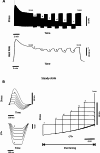Sex differences in cardiac energetics in the rat ventricular muscle
- PMID: 39732777
- PMCID: PMC11682250
- DOI: 10.1038/s41598-024-82604-3
Sex differences in cardiac energetics in the rat ventricular muscle
Abstract
Cardiac sex-difference functional studies have centred on measurements of twitch force and Ca2+ dynamics. The energy expenditures from these two cellular processes: activation (Ca2+ handling) and contraction (cross-bridge cycling), have not been assessed, and compared, between sexes. Whole-heart studies measuring oxygen consumption do not directly measure the energy expenditure of these activation-contraction processes. In this study, we directly quantified these energy expenditures in terms of heat production. Left-ventricular trabeculae were dissected from rats aged 9-13 weeks. Mechano-energetics of trabeculae were characterized using our work-loop calorimeter under various conditions including varying muscle lengths, stimulus frequencies, and afterloads. Each trabecula was subjected to protocols that allowed it to contract either isometrically or shorten to perform work-loops. Force production, length change, and heat output were simultaneously measured. We extracted various metrics: twitch kinetics, shortening kinetics, mechanical work, and heat associated with cross-bridge cycling and Ca2+ cycling, and quantified mechanical efficiency. Results show no sex differences in any of the metrics. Peak mechanical efficiency was not affected by sex (10.25 ± 0.57% in female trabeculae; 10.93 ± 0.87% in male trabeculae). We conclude that cardiac mechanics and energetics are not affected by sex at the muscle level, within the rat age range studied.
Keywords: Cardiac efficiency; Cardiac mechanoenergetics; Female; Force-length; Heat Production; Mechanical work.
© 2024. The Author(s).
Conflict of interest statement
Declarations. Competing interests: The authors declare no competing interests.
Figures








Similar articles
-
Cardiac muscle contracts more efficiently at lower contraction frequencies.Exp Physiol. 2025 Apr;110(4):561-573. doi: 10.1113/EP092367. Epub 2025 Jan 29. Exp Physiol. 2025. PMID: 39888146 Free PMC article.
-
Slower shortening kinetics of cardiac muscle performing Windkessel work-loops increase mechanical efficiency.Am J Physiol Heart Circ Physiol. 2022 Sep 1;323(3):H461-H474. doi: 10.1152/ajpheart.00074.2022. Epub 2022 Jul 29. Am J Physiol Heart Circ Physiol. 2022. PMID: 35904884
-
Do right-ventricular trabeculae gain energetic advantage from having a greater velocity of shortening?J Physiol. 2017 Oct 15;595(20):6477-6488. doi: 10.1113/JP274837. Epub 2017 Sep 24. J Physiol. 2017. PMID: 28857176 Free PMC article.
-
Relating components of pressure-volume area in Suga's formulation of cardiac energetics to components of the stress-time integral.J Appl Physiol (1985). 2012 Oct;113(7):988-95. doi: 10.1152/japplphysiol.00438.2012. Epub 2012 Jul 26. J Appl Physiol (1985). 2012. PMID: 22837173 Free PMC article. Review.
-
Cardiac heat production.Annu Rev Physiol. 1979;41:507-19. doi: 10.1146/annurev.ph.41.030179.002451. Annu Rev Physiol. 1979. PMID: 219764 Review.
Cited by
-
Human cardiac tissues produce lower contractile stress and exhibit slower cross-bridge cycling in type 2 diabetes.Cardiovasc Diabetol. 2025 Jul 3;24(1):266. doi: 10.1186/s12933-025-02820-7. Cardiovasc Diabetol. 2025. PMID: 40611280 Free PMC article.
References
-
- Wu, J., Dai, F., Li, C. & Zou, Y. Gender differences in cardiac hypertrophy. J. Cardiovasc. Transl. Res.13, 73–84. 10.1007/s12265-019-09907-z (2020). - PubMed
MeSH terms
Substances
Grants and funding
- 1875/National Heart Foundation of New Zealand
- 1896/National Heart Foundation of New Zealand
- David J. Crossman Senior Research Fellowship/National Heart Foundation of New Zealand
- 1929/National Heart Foundation of New Zealand
- 21/653/Manatu Hauora | Health Research Council of New Zealand (HRC)
- 21/116/Manatu Hauora | Health Research Council of New Zealand (HRC)
- 20/011/Manatu Hauora | Health Research Council of New Zealand (HRC)
- Andrew J. Taberner James Cook Research Fellowship/Royal Society Te Apārangi
- MFP-UOA2206/Royal Society of New Zealand | Marsden Fund (Royal Society of New Zealand Marsden Fund)
LinkOut - more resources
Full Text Sources
Miscellaneous

